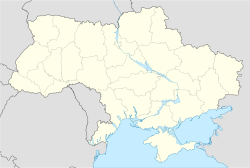- Maydanets
-
Maydanets
МайданецMap of Ukraine with Maydanets highlighted. Location of Maydanets Coordinates: 48°48′36″N 30°42′01″E / 48.81°N 30.70028°ECoordinates: 48°48′36″N 30°42′01″E / 48.81°N 30.70028°E Country
Oblast
RaionUkraine
Cherkasy Oblast
Talne RaionVillage Elevation 169 m (557 ft) Population 2069 voters - Total 5,005 Postal code 20442 Area code(s) +380 4731 Maydanets (Ukrainian: Майданец), Ukraine, also referred to as Maydanets'ke or Maydanetske (Ukrainian: Майданецьке) or Maydanetskoya (Ukrainian: Майданецкое), is located within the Talne Raion (district) of the Cherkasy Oblast (province), about 235 kilometers (146 mi) driving distance south of Kiev. It is a small farming community located primarily on a hill overlooking the Tal'ianki River. Maydanets is home to one of the three district hospitals in the Talne Raion. A local museum was built in the 1990s that highlights the rich and ancient history of this community, including a panoramic reconstructed model of the large Cucuteni-Trypillian settlement, as well as some of the artifacts uncovered from around the village.
Maydanets was the location of two separate settlements of the Neolithic Cucuteni-Trypillian culture. The first settlement, encompassing about 2 hectares (5 acres), was inhabited near 5000 BC, and is located close to the outskirts of Maydanets along the road to Talne at a location called Grebenyukov Yar (Ukrainian: Гребенюков Яр). This site was partially excavated by M. Shmaglij and N. Burdo between 1981–1989, during which time three dwellings and two bordei (earth-sheltered dwellings) were discovered and examined.[1]
The second, much larger Cucuteni-Trypillian settlement is located on the left bank of the Tal'ianki River, west of Maydanets, which was inhabited near 3700-3600 BC. The settlement encompassed about 250 hectares (600 acres), measuring 1.5 kilometers (0.93 mi) in length and 1.1 kilometers (0.68 mi) wide, and was laid out in an oval pattern. This site was explored by an archaeologcal team led by M. Shmalij from 1971 to 1991, who employed magnetometric analysis to map out the settlement (made by V. Dudkin), revealing a total of 1575 buildings, including dwellings, fortifications, sanctuaries, and some two-storied houses (on 180 ha explored area). The excavation of the site produced almost 50 artifacts, including a unique collection of painted pottery and figurines. This settlement was one of the largest of the Cucuteni-Trypillian, making it also one of the largest settlements in the world during the time that it flourished.[2]
In addition to the two Cucuteni-Trypillian cultural sites, Maydanets is also the location two other ancient archaeological sites. Two Yamna culture tumuli (burial mounds) are located near the village, containing eight graves dating back to the middle of the 3rd Millennium BC. Also, in the nearby Geliv Stav location, are the remains of a small settlement dating to the 4th century AD of the Chernyakhov culture.[2]
In addition to the local museum in Maydanets, archaeological artifacts taken from local sites may be found in the Cherkasy Regional Museum, the Museum of Agriculture in Talne, the National Museum of History in Kiev, and the Institute of Archaeology, also in Kiev. There are also other nearby towns that are host to Neolithic settlements, including the village of Talianki, where the largest of all the Cucuteni-Trypillian settlements is located.
See also
- Yamna culture
- Neolithic Europe
- Chalcolithic Europe
- Prehistory of Southeastern Europe
- History of Ukraine
References
- ^ [|Videiko, Mykhailo Yu.]; Shmaglij, M. (1987). "Раннетрипольское поселение Гребенюков Яр у с. Майданецкоe [Early Tripolye settlement Grebenyukov Yar near Maidanetskoye village]" (in Russian). Новые исследования по археологии Северного Причерноморья [New research on the archeology of the Northern Black Sea]. Kiev: Наукова думка (Naukova Dumka). pp. 87–89.
- ^ a b Videiko, Mykhailo Yu.. "Settlements of the Trypillian culture in Ukraine : a short guide". The Trypillian Civilization Society. The Trypillia-USA-Project. http://www.trypillia.com/articles/eng/se3.pdf. Retrieved 15 December 2009.[dead link]
External links
- The Trypillia-USA-Project The Trypillian Civilization Society homepage (in English).
- The Institute of Archaeomythology The homepage for The Institute of Archaeomythology, an international organization of scholars dedicated to fostering an interdisciplinary approach to cultural research with particular emphasis on the beliefs, rituals, social structure and symbolism of ancient societies. Much of their focus covers topics that relate to the Cucuteni-Trypillian Culture (in English).
- Trypillian Culture from Ukraine A page from the UK-based group "Arattagar" about Trypillian Culture, which has many great photographs of the group's trip to the Trypillian Museum in Trypillia, Ukraine (in English).
- Трипільська культура в Україні з колекції «Платар» Ukrainian language page about the Ukrainian Platar Collection of Trypillian Culture.
Administrative divisions of Cherkasy Oblast, Ukraine Administrative center: Cherkasy Raions Cherkasy · Chornobay · Chyhyryn · Drabiv · Horodyshche · Kamyanka · Kaniv · Katerynopil · Khrystynivka · Korsun-Shevchenkivskyi · Lysianka · Mankivka · Monastyryshche · Shpola · Smila · Talne · Uman · Zhashkiv · Zolotonosha · Zvenyhorodka

Cities Cherkasy · Chyhyryn · Horodysche · Kamianka · Kaniv · Khrystynivka · Korsun-Shevchenkivskyi · Monastyrysche · Shpola · Smila · Talne · Uman · Vatutine · Zhashkiv · Zolotonosha · ZvenyhorodkaUrban-type
settlementsVillages Categories:- Cities and villages in Talnivskyi Raion
- Villages in Cherkasy Oblast
- Villages in Ukraine
- Archaeological sites in Ukraine
- Former populated places in Ukraine
- Archaeology of Ukraine
- Stone Age Europe
- Archaeological cultures
- Tumuli in Ukraine
- Prehistory of Southeastern Europe
- Neolithic Europe
Wikimedia Foundation. 2010.


